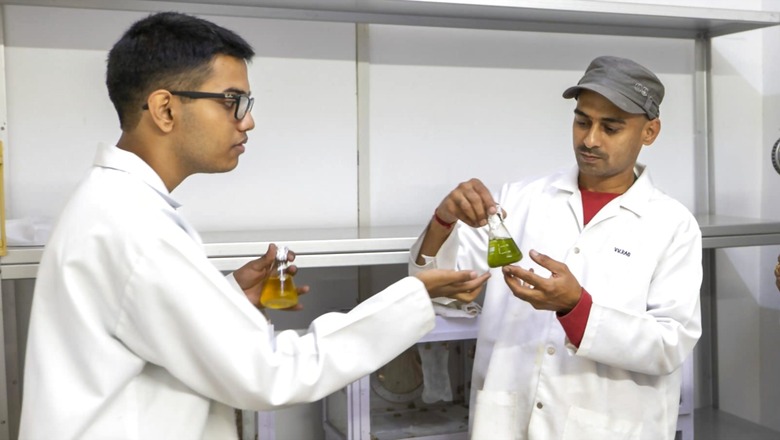
views
A 17-year-old research intern at the International Crops Research Institute for the Semi-Arid Tropics (ICRISAT) in Hyderabad recently won the third prize in the International Science and Engineering Fair in Atlanta, USA, for developing an insecticide from Ramphal (soursop) leaves. The department of science and technology, Government of India, also awarded Sarvesh Prabhu the first prize and Rs 100,000 ($1224) as part of the Council of Scientific and Industrial Research (CSIR) Innovation Award for School Children.
The high school student from FIITJEE Junior College, Hyderabad, presented the project titled ‘A novel study of bio-insecticidal properties of Annona reticulata’ at the international fair. Describing how he came up with the idea, Sarvesh told News18: “During lockdown, my sister and I decided to try our hands at gardening at our grandparents’ home. To our utter dismay, all of our precious plants that we had tried to grow were being eaten by insect pests leading to a terrible harvest. At the time my sister wanted to use chemical insecticides that were available in the house while I was absolutely against it for environmental reasons. From that quarrel arose the possible use of botanical insecticides as an alternative. Ramphal grows in our garden and we noticed that it flourished when pests damaged all other plants. Thus began my project in the middle of the pandemic.”
Sarvesh found that extracts from Ramphal leaves could be effective against three disastrous pests (Helicoverpa armigera, Myzus persicae, Spodoptera frugiperda) with the mortality rate ranging from 78-88%. So how far is it from being developed into a commercial product?
“Currently, we were doing experiments based on crude plant/leaf extract tests on various early stages of insect pests under lab conditions. There is a need for further tests under greenhouse and field conditions for their efficacy in managing insect pests. We need to further explore complete metabolomic profiling for the identification of target and non-target secondary metabolites present in leaf samples which influence the defence mechanism for insect pests. Commercial production of this pesticide in the future will be based on all the above studies. Already most of the smallholder farmers in villages use the traditional way using other plant-based biopesticides (neem plant) for managing pests and diseases. This pesticide also can be used by farmers to manage pests,” Sarvesh says.
“We maintain five insect cultures throughout the year, making it a one-of-its-kind research facility in India and supporting/providing insect cultures to many Indian Council of Agricultural Research (ICAR) institutes, state agricultural universities, and private companies for their research activities on toxicology and host plant resistance,” said Dr Jagdish Jaba, Scientist- Entomology, Crop Protection and Seed Health, ICRISAT.
Talking about the time spent in developing the bioinsecticide, Sarvesh says: “It took about a year to reach this stage. However, a lot of it was on and off due to school exams, travelling, and moving cities. With the help and good mentor support from ICRISAT, I was given extreme flexibility to carry out lab experiments based on my availability period.”
How are bioinsecticides better than chemical ones?
A) Human health: Acute effects of exposure to insecticides include stinging eyes, rashes, blisters, blindness, nausea, dizziness, diarrhoea and death. While chronic effects of these chemicals are much more devastating. These include cancers, birth defects, reproductive harm, neurological and developmental toxicity, immunotoxicity, and disruption of the endocrine system. 6,600 farmers die of insecticide poisoning every year in India.
B) Biotic components of ecosystems: Exposure to insecticides can affect an organism’s behaviour, impacting its ability to survive. In birds, for example, exposure to certain insecticides can impede singing ability, making it difficult to attract mates and reproduce. Insecticides can also affect birds’ ability to care for offspring, causing their young ones to die. For bees, even near-infinitesimal levels of systemic insecticides result in sublethal effects, impacting mobility, feeding behaviours, and navigation.
C) Abiotic components of ecosystems: Over time, insecticides reduce soil quality and fertility. They kill non-target organisms that are essential to replenish the soil. Runoffs from farms flow into streams and rivers which poses a lethal risk from the downstream areas and habitats. Insecticides also contribute to air pollution. Suspended particles of insecticides drift to other places and contaminate them and pose risk to people. The toxins in these insecticides have done irreparable damage to land and are a leading cause of air and water pollution. These pesticides also affect many natural enemies (predators and parasitoids) of major insect pests.
Read all the Latest India News here













Comments
0 comment